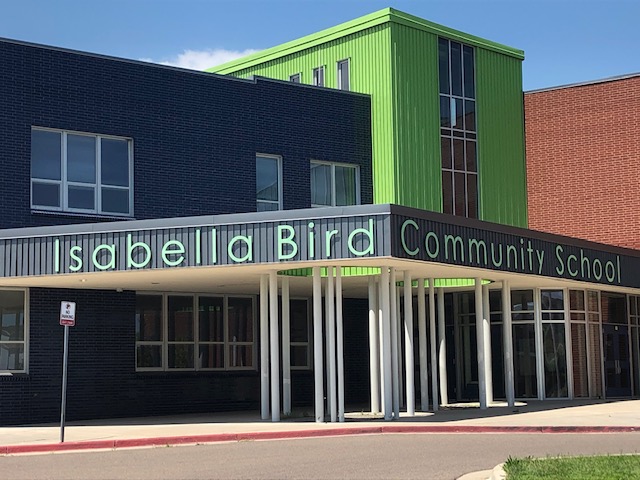By Hannah Hudson
Isabella Bird in Central Park leads Denver Public Schools with the highest percentage of students who are identified as gifted and talented outside of magnet GT programming.
Izzi B is also the only Central Park school with a fulltime GT program.
In 2023–2024, DPS projects that 18% of Izzi B’s students will be identified highly/gifted and talented, and 6% will move toward full identification as GT, or 24%; it was 17% this year .
The GT percentages come from data gathered by DPS about all its schools. Other Central Park schools range from 3-10%. DPS has nearly 100 elementary schools; seven are GT magnets.
“We have worked diligently to build an inclusive, full-time GT model designed to support students at a neighborhood school,” said Principal Rebecca Mercer who has been on the staff since Izzi opened in 2013.
Mercer noted that for all the talk about equity and inclusion, GT students get overlooked.
“We tell HGT students to get on a bus to go to a different school” other than the one in their neighborhood, she said. “We hold deep value in serving the students in the community in which we live.
“That means students are drawn to our school who are gifted and talented because they know they will be seen, valued and served.”
Mercer credits teachers, the leadership team and the parent community for creating a school culture based on serving all students as if they are GT. A teacher at each grade level is certified in GT teaching practices.
Another reason for the large percentage, Mercer said, is the staff’s commitment to review achievement data as a regular part of identifying GT students.
“We believe in talent development’’ of students on the verge of being designated GT, Mercer said. “Our intentional placement of those students into the GT cluster means we can build on innate gifts, so they are expressed with academic achievement.”
What else makes Izzi B’s programming unique and successful? And how does the ECE-5 school meet the needs of all students, whether they’re identified as gifted or not?
Three practices that answer those questions.
1. Izzi B offers equitable, full-time gifted programming through a research-based cluster grouping model for its 414 students.
At many district schools, gifted services are provided with a pull-out model, where students visit a resource room for an hour or two a week. But as Dr. Robin Tobin, the lead gifted and talented teacher at Izzi B, points out, “gifted kids aren’t just gifted for an hour or two a week. They’re gifted all day long.”
That’s why Izzi B remains committed to the schoolwide cluster grouping model to support students through full-time gifted programming, where the regular classroom is truly the primary place of learning for all kids.
Isabella Bird embarked on this research-based model seven years ago and the GT program has continued to grow and thrive since then.
In 2016-17, Izzi B engaged in a partnership with renowned experts in year-long professional learning called the Equitable Access to Education Cohort. The school’s leadership team and several teachers traveled to Arizona to meet Dr. Susan Winebrennar, creator of the Schoolwide Cluster Grouping Model (SCGM), and observed the model at work in several schools.
Dr. Winebrennar has implemented the SCGM in a large district, Paradise Valley Unified north of Phoenix, with proven results for all kids, including increased performance in math and a more diverse group of students who are identified as gifted. This work involved cultural surveys, school wide environmental scans, focus groups, and site visits from Dr. Eddie Fergus, author of Solving Disproportionality and Achieving Equity: A Leader’s Guide to Using Data to Change Hearts and Minds.
There are a few key elements that make this model work. First, at least one teacher at every grade level is currently gifted-certified, and all the teachers at Izzi B are working toward certification through the DPS certification program.
This certification ensures that teachers understand the nature and needs of gifted learners and are well-prepared to adjust their instruction to meet those needs.
Second, gifted students are clustered together in groups in a regular classroom, so that they have the benefit of learning alongside kids with similar strengths and needs. There are currently two cluster groups within every grade level at Izzi B, except fifth, which has three.
Finally, in first through fifth grades, the teachers at Isabella Bird are content specialists, meaning they focus on one academic area like math or reading, and students learn from all teachers at each grade level.
This specialization allows teachers to provide a higher degree of differentiation to teach their content more effectively to all students, including those who have already mastered grade-level content. Several math teachers at Izzi B, for example, are qualified to teach middle and high school level math to students who need it.
2. Izzi B places a special focus on equitable programming.
“We absolutely know that gifted and talented students are present in all student groups, regardless of gender, disability, English language proficiency, economic status, or ethnic or cultural background,” says Jessica Wainman, a fourth-grade teacher at Izzi B.
“Our program is designed to lift up and recognize the brilliance of underrepresented populations.”
On a practical level, that means Izzi B considers a wide number of factors in identifying students as gifted or in adding them to the “talent pool” for future identification. These include parent interviews, teacher observations and assessments beyond the traditional Naglieri Nonverbal Ability Test (NNAT) and Cognitive Abilities Test (CoGAT) that are used by most schools.
And Izzi B doesn’t wait for formal identification to begin providing services. If it’s clear a child needs advanced programming, they receive it while the school builds the body of evidence for identification.
“It takes time to build a body of evidence, and we’d never wait to provide programming for a child,” says Tobin, lead GT teacher.
3. Izzi B’s cluster model benefits all students.
Principal Mercer notes that the cluster grouping model has clear benefits for every child in the building. DPS’s coursework for certification in gifted education ensures instructional staff are well-prepared to meet the needs of all students, including those who are gifted.
Research shows that grouping can help to improve the academic performance of students at all achievement levels if implemented with appropriate curriculum, instruction, and expectations.
Christina Johnson, a parent of two students at Izzi B, agrees that the school offers a unique environment where kids of all abilities can thrive.
“If you have children with different needs like I do,” Johnson says, “you don’t have to hassle with two different drops-offs and school schedules to juggle.
“Everyone can get their needs met at Izzi B.”
If you’d like to learn more about the gifted program at Izzi B, you can watch a recording of their Gifted & Talented night presentation here.
Other resources:
DPS GT site
https://sites.google.com/dpsk12.net/dpsgt/home
Available services from DPS
https://sites.google.com/dpsk12.net/dpsgt/gt-programs-and-services-in-dps
Family information about GT
https://sites.google.com/dpsk12.net/dpsgt/home
Hannah Hudson was born and raised in Denver and is a Central Park mom of two Izzi B students. She’s the editor of WeAreTeachers, an online community for K-12 teachers. https://www.weareteachers.com/




